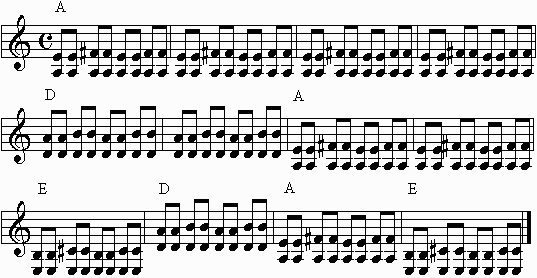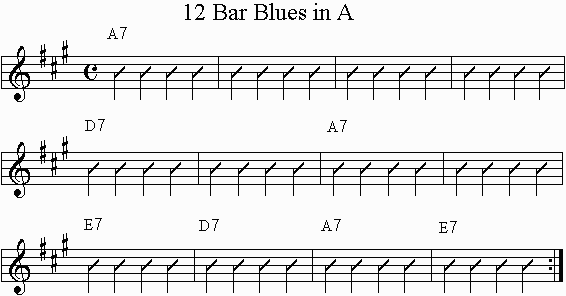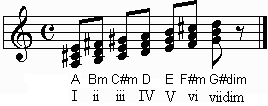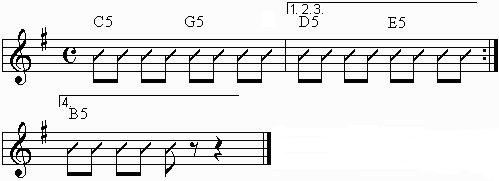 |
| Lesson 8 | |||||||||||||||||||||||||||||||||||||||||||||||||||||
| In
this lesson we will look at the 5th position C major/A minor scale. We will also
look at the blues scale , a basic blues riff and the 12 bar blues form. Review Lesson 7 | |||||||||||||||||||||||||||||||||||||||||||||||||||||
| | |||||||||||||||||||||||||||||||||||||||||||||||||||||
|
Scales - 5th position C major/A minor To play a C major scale in 5th position we will have to start on the 8th fret of our low E string. This is the exact same C that we used in the other previous C scale positions. So when you see that C starting the scale on the staff below, you can play it on either the 3rd fret of your A string or the 8th fret of your low E string.
Play from C to C for a C major scale and play from A to A for an A minor scale. This is a 5th position scale so your index finger looks after the 5th fret, middle finger looks after the 6th etc., however the pinky will have to stretch to the 9th fret on the D string to get the B. Some people like to play this scale where you shift back to 4th position to get the B on the 4th fret of the G string. If you do that you will want to shift back to 5th position for the 2nd and 1st string. Make pentatonic by removing the 4th and 7th from the major scale. Play from A to A and you are playing an A minor pentatonic scale and play from C to C and you are playing C major pentatonic scale:
A Blues Scale The blues scale is a minor pentatonic scale with one extra note. It is a lowered 5th degree or you could call it a flat 5th (b5). The 5th degree of an A minor scale would be E and so we add a b5 which in this case would be Eb. Listen - right click to open in new window
| |||||||||||||||||||||||||||||||||||||||||||||||||||||
| | |||||||||||||||||||||||||||||||||||||||||||||||||||||
| Chords - E | |||||||||||||||||||||||||||||||||||||||||||||||||||||
|
We have played E minor now for quite a few lessons. To make it E major we will have to raise the 3rd. The 3rd of an Em chord was G and so we will play the 1st fret of our G string to give us a G#. You can play all 6 strings. |  | ||||||||||||||||||||||||||||||||||||||||||||||||||||
| | |||||||||||||||||||||||||||||||||||||||||||||||||||||
| Basic Blues Riff and Swing Eighth notes | |||||||||||||||||||||||||||||||||||||||||||||||||||||
|
Here is a one of the most popular blues riffs of all time and we will look at it played as straight eighth notes and swing eighth notes. After we have the riff we will apply it to the basic 12 bar blues. Swing eighth notes are actually part of a triplet. It is like playing the 1st and 3rd note of a triplet. Learn more here and than use back on your browser to return to this lesson. The low note on the staff below is A and the note on the first line is E from Every Good Boy Does Fine. | |||||||||||||||||||||||||||||||||||||||||||||||||||||
 | |||||||||||||||||||||||||||||||||||||||||||||||||||||
| Start with your 1st finger on the E (2nd fret or your D string). Play your open A and the E together twice. |  | ||||||||||||||||||||||||||||||||||||||||||||||||||||
| Next put your 3rd finger on F# (4th fret of D string). Leave your first finger down because after you play the A and F# twice you will go back to A and E. | |||||||||||||||||||||||||||||||||||||||||||||||||||||
 | |||||||||||||||||||||||||||||||||||||||||||||||||||||
| |||||||||||||||||||||||||||||||||||||||||||||||||||||
| | |||||||||||||||||||||||||||||||||||||||||||||||||||||
| 12 Bar Blues Form | |||||||||||||||||||||||||||||||||||||||||||||||||||||
| The standard 12 bar blues consists of 3 chords. The I IV V So to find the I IV V chords in the key of A, we will start by building an A major scale:
Note: the scale degrees under the note names. Next we will build the diatonic triads from the scale: | |||||||||||||||||||||||||||||||||||||||||||||||||||||
|
| |||||||||||||||||||||||||||||||||||||||||||||||||||||
|
Note: the roman numerals under the chord names. So the I IV V chords in the key of A are: A D E | |||||||||||||||||||||||||||||||||||||||||||||||||||||
|
A |
D |
E | |||||||||||||||||||||||||||||||||||||||||||||||||||
 |  |  | |||||||||||||||||||||||||||||||||||||||||||||||||||
|
The basic 12 bar blues has us play the I chord for the first 4 bars (measures) and then the IV chord for measures 5 and 6. Then back to the I chord for measures 7 and 8. The start of the 3rd line has us play the V chord for measure 9, IV chord for measure 10 and the I chord for measure 11 and quite often 12. However, in the example below (and video) we will play the V chord as a turnaround to take us back to the top. Measure 11 and 12 are called the turnaround. To play the example below you will play the riff you learned in this lesson 4x and then move the riff to D. To do that you will move your first finger to the 2nd fret or you G string (A) and you will play open D instead of open A. So do the same thing you did on strings 4 and 5 for A as you will do on strings 3 and 4 for D. Then for E you will move your 1st finger to the 2nd fret of your A string and play open E. So again the same thing but on strings 5 and 6. The video below will hopefully clarify any concerns. | |||||||||||||||||||||||||||||||||||||||||||||||||||||
 | |||||||||||||||||||||||||||||||||||||||||||||||||||||
|
The notation above shows measure 12 with the same blues riff as measure 9 but on the video, measure 12 is played as eighth note triplets on low E. There are 3 eighth note triplets in a beat so you will have a total of 12 E's for the V chord turnaround.
| |||||||||||||||||||||||||||||||||||||||||||||||||||||
| | |||||||||||||||||||||||||||||||||||||||||||||||||||||
 | |||||||||||||||||||||||||||||||||||||||||||||||||||||
|
Listen - midi file for slower connections or for use with midi sequencer | |||||||||||||||||||||||||||||||||||||||||||||||||||||
| | |||||||||||||||||||||||||||||||||||||||||||||||||||||
| Greenday - Blvd. of Broken Dreams - chorus We are back to our power chords to learn the next part of this huge Greenday hit. This time we are going to play most of these power chords on strings 3 4 5 instead of the 4 5 6. So when we see C5, we can play it in either 8th position on strings 4 5 6 or 3rd position on strings 3 4 5. The only real difference is that you will have to block the 6th string when you play in 3rd position. It is usually blocked by either gently resting your middle finger of your fret hand across it or bringing your thumb up around and gently touching it. We are also seeing the repeat sign with multiple endings. You repeat the first line 3 times and than on the 4th time you take the 4th ending after playing C5 and G5. | |||||||||||||||||||||||||||||||||||||||||||||||||||||
| |||||||||||||||||||||||||||||||||||||||||||||||||||||
| | |||||||||||||||||||||||||||||||||||||||||||||||||||||
| Practice Scales - C major and C major pentatonic in 1st, 1st with shift, 2nd and 5th positions, A minor in 5th, G major and E minor in 1st. Scale pattern 123, 234, 345. Get good at it in one position before worrying about the pattern with all the scales you are working on. Eventually you be able to play the pattern with all your scale forms. Chords - Em, A, C, Am, G, D, Dsus4, Asus4, GtypeII,
Cadd2, E and the power chord on string 5 and 6. Chord progressions: Arpeggio - D major in 2nd. Try practicing it along with the Free Falling mp3. It also works well to use over the tripfuse jam on Mr. Nothin. Jam track can be found on myspace/guitarsoloing Improvising - C major scale and pentatonic with Brainstew mp3 and C to Am jam, 2nd position D major scale and D arpeggio along with Free Falling mp3 and jam track on myspace link above. A minor pentatonic and A blues scale along with the blues jam on this lesson or blues lesson from free section. Reading - the reading lessons are picking up steam so keep reviewing and trying to spend a few minutes everyday reading.
Review Lesson 7 Move on to Lesson 9
| |||||||||||||||||||||||||||||||||||||||||||||||||||||
| Vancouver British Columbia Canada 604 357-3551 http://www.musiclearning.com |













